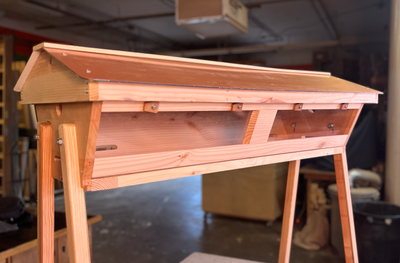Brood Frame Basics
Mastering the skill of reading a brood frame takes time. But with practice and some helpful guidance, your understanding of the brood nest will eventually become second nature.
Brood frames are generally located through the center of the hive's built out frames. If you aren’t using a queen excluder and have several boxes worth of actively occupied frames you may see that the bees build a more narrow and vertical brood area extending the height of the hive. That being said, sometimes the queen will settle in one box and just stay there. All colonies are unique and observing how yours likes to arrange their brood area is a wonderful way to better understand your bees and the seasonal influences of your location.
No matter what type of hive or frames you and your bees are working with, the makeup of a healthy brood nest should consist of these elements: eggs, larva, capped brood, pollen, nectar, capped honey, a queen bee and nurse bees. Depending on the time of year, in addition to seeing worker brood, you will see drone brood and queen cells or queen cups in the brood nest as well.
When the queen lays her eggs she should be laying in a radial pattern that starts near the center of the frame and working her way outwards. When the frame is nearly full of eggs, she will move onto another frame to continue her work. As the season progresses there will be some deviation from this starting point. Food storage, colony health, and queen health can have an impact on the brood pattern.
The nurse bees care for the eggs and larvae, making sure they are warm and well fed throughout these developmental stages. Once the larvae is ready for pupation the nurse bees will add a wax capping to protect the larva as it begins its final transformation into a fully formed bee. In terms of brood, you may see a mix of frames with only eggs and larvae, or frames of mostly capped brood. These frames should all have a nice congregation of nurse bees on them.
The brood frame needs to have food stores close at hand for the nurse bees to feed the larvae. Pollen is often found in a band or ring surrounding the brood area, followed by nectar or capped honey. Larvae are fed royal jelly, bee bread, and nectar/honey. When a nurse bee consumes bee bread (pollen fermented with nectar and water), it stimulates the glands that produce royal jelly. Having well fed nurse bees means having well fed larvae!
Disruptions in forage availability, quality, and even forager population can have an impact on the brood area. You will notice that throughout the year there are fluctuations in the amount of brood. Other times, you may see that your brood frames are being backfilled (meaning when a bee hatches out of its cell, the cell then gets filled with nectar or pollen). These are important clues to help guide your next steps as colony manager.
Bee sure to keep an eye on our blog for more tips and tricks!
Happy beekeeping,
- Mandy Shaw
A brood frame with backfilling of brood cells can indicate: a strong nectar flow, the need for additional space, or the brood nest contraction that occurs as a colony prepares for winter.
A frame showing solid bands of honey and pollen wrapping around the brood area. This is an ideal positioning and ratio of food stores to brood.
An ideal radial brood pattern is shown here with older larvae in the center transitioning to eggs on the outer edges of the brood area, surrounded by a healthy swath of pollen.
A queen bee moving among her daughters. Notice the older capped brood along side of younger uncapped brood.
The brood nest is the heart of the hive and should be handled with extreme care and sensitivity to internal and external hive stressors such as weather, forage, time of day, and time of year.





